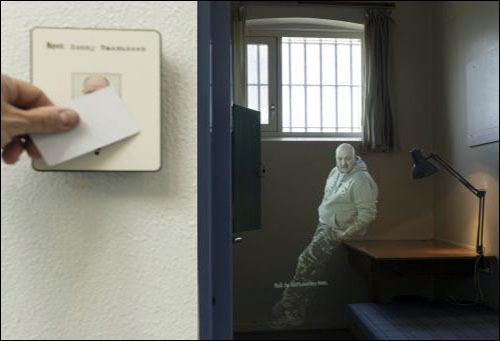A decade after being shut down, Denmark’s Horsens State Prison has reopened as the Horsens Prison Museum, a place where visitors carry RFID tags to link them up with some of the site’s 150-year history. The RFID-enabled system was devised and installed by Danish exhibition design company Kvorning Design & Communication. The technology allows visitors to access videos, photographs and information specific to a historical character whom they have selected. In this way, guests not only can see the prison as it looked when it was active, but can also follow the lives of the individuals who spent time there.
The prison closed its doors to inmates in 2006 following a 150-year run as a lockup for the country’s worst convicts. A museum opened temporarily at the site in May 2012, at which time guests were able to walk through the prison’s cells and see what the facility consisted of, though there were few exhibits related to what life would have been like at the time that the prison was in operation. In May 2015, the 4,000-square-meter (43,000-square-foot) museum launched the RFID system to bring a more vivid experience in the form of “identity trails” enabling visitors to follow the lives of specific jail inmates and guards. Visitors can simply tap cards containing NXP Semiconductors high-frequency (HF) 13.56 MHz Mifare RFID chips near readers built by Kvorning Design & Communication, using the Arduino open-source electronics platform.

Upon arriving at the museum, visitors each purchase a ticket and choose any of the 10 characters they wish to follow. These characters—former inmates and guards—represent a sampling of the prison’s history, such as Carl August Lorentzen, who escaped in 1949 by digging an 18-meter-long (59-foot-long) tunnel to freedom. The museum provides the visitor with an RFID card for each character whom he or she has chosen to follow. In the system, the unique ID number of each character’s card has been linked to information that the visitor can access about that individual.
The museum is intended to replicate the prison’s bleak atmosphere. Therefore, illumination is provided by muted fluorescent lights. However, the exhibits use video and audio recordings to create an experience as though some of the prisoners and guards were still onsite. To trigger the playing of specific video and audio content, Kvorning installed RFID readers at a variety of locations throughout the museum. Each character has a total of eight readers dedicated to his story in the prison tour. Visitors place their RFID tags within a few centimeters of each reader in order to activate the display of images and video, by means of 50 laser projectors and approximately 30 touchscreens installed throughout the facility.
At the first stop, visitors can use their RFID cards to view information regarding the character each has selected. The information is provided in a variety of formats. For example, the exhibit presents a green-screen, life-size version of former prisoner Sonny Rasmussen, based on a video in which he discussed the time he spent there. In addition, Dan Karl Christensen maintained a journal while serving his prison term, and the words are “typed out” on the walls, tables and other surfaces, accompanied by the sounds of a typewriter.
Subsequent stops show different aspects of life at the prison—in its cells, church and hospital, for instance—for that character and others living there. At the eighth (and final) stop, visitors hold their tags near a reader—there is one for each of the 10 characters—and view information about that individual’s life after he left Horsens. Additionally, the visitor is invited to input his or her e-mail address to receive a “secret code” that grants access to additional material on the museum’s website regarding the character’s identity. That e-mail address can then be used to send the guest promotional information about the museum and its future exhibits.
Kvorning provided the software that captures each tag read and links that data to content relevant to the guest’s character card. The software resides on a local server and serves only as a means of linking visitors with content. It does not collect any data related to how often the tags are used, or which characters are most popular, says Rasmus Woller Stoumann, Kvorning Design & Communication’s project coordinator. Information is stored locally, he adds, since “to network it all for a central-based solution would cost a lot of time and money due to the old… buildings.”

Visitors have responded well to the RFID system, says Anne Bjerrekaer, the museum’s director. “We had many discussions on how our guests should be introduced to the identities,” she states, “and we are very happy that we decided to let the guest make his or her own choice.” With the RFID system, Bjerrekaer notes, each visitor can access the information that interests him or her, even if other members of that person’s group are following another character.
Visitors are not required to select a specific character to follow, Bjerrekaer says, though most do so. A guest who declines to select a character, however, will not receive an RFID card and will, therefore, be unable to activate any video or audio content. About 10 percent of visitors choose more than one character to follow, she says. “It’s very interesting to observe the selection of badges,” she adds. “Our guests take their time, read the introductions, talk and discuss.” The RFID badge identities are receiving high reviews at the TripAdvisor website and on social media, Bjerrekaer reports. With RFID, she says, “you can offer much more information without jeopardizing the authentic atmosphere of the building,” which could occur if signage or placards were installed.
In May of next year, the museum plans to open a reconstructed version of the tunnel originally dug by Lorentzen. RFID readers may be installed at that location as well, to provide relevant content.



